Enhanced NO2 Sensing Performance of ZnO-SnO2 Heterojunction Derived from Metal-Organic Frameworks
Abstract
1. Introduction
2. Experimental
2.1. Synthesis of Zn/Sn Bimetallic MOF
2.2. Synthesis of Zn-BDC MOF and Sn-BDC MOF
2.3. Synthesis of ZnO-SnO2 Metal Oxides
2.4. Preparation of Gas Sensor and Sensing Measurements
2.5. Characterization
3. Results and Discussion
3.1. Material Characterization
3.2. Gas Sensing Properties
3.3. NO2 Sensing Mechanism
4. Conclusions
Supplementary Materials
Author Contributions
Funding
Institutional Review Board Statement
Informed Consent Statement
Data Availability Statement
Conflicts of Interest
References
- Kim, D.; Chen, Z.; Zhou, L.F.; Huang, S.X. Air pollutants and early origins of respiratory diseases. Chronic Dis. Transl. Med. 2018, 4, 75–94. [Google Scholar] [CrossRef] [PubMed]
- Schwartz, J.; Spix, C.; Wichmann, H.E.; Malin, E. Air pollution and acute respiratory illness in five german communities. Environ. Res. 1991, 56, 1–14. [Google Scholar] [CrossRef]
- WHO. WHO Global Air Quality Guidelines: Particulate Matter (PM2.5 and PM10), Ozone, Nitrogen Dioxide, Sulfur Dioxide and Carbon Monoxide; World Health Organization: Geneva, Switzerland, 2021. [Google Scholar]
- Yang, X.; Zhang, Y.; Hao, X.; Song, Y.; Liang, X.; Liu, F.; Liu, F.; Sun, P.; Gao, Y.; Yan, X.; et al. Nafion-based amperometric H2S sensor using Pt-Rh/C sensing electrode. Sens. Actuators B 2018, 273, 635–641. [Google Scholar] [CrossRef]
- Hsueh, T.-J.; Wu, S.-S. Highly sensitive Co3O4 nanoparticles/MEMS NO2 gas sensor with the adsorption of the Au nanoparticles. Sens. Actuators B 2021, 329, 129201. [Google Scholar] [CrossRef]
- Miller, D.R.; Akbar, S.A.; Morris, P.A. Nanoscale metal oxide-based heterojunctions for gas sensing: A review. Sens. Actuators B 2014, 204, 250–272. [Google Scholar] [CrossRef]
- Alenezi, M.R.; Henley, S.J.; Emerson, N.G.; Silva, S.R. From 1D and 2D ZnO nanostructures to 3D hierarchical structures with enhanced gas sensing properties. Nanoscale 2014, 6, 235–247. [Google Scholar] [CrossRef]
- Yuan, H.; Aljneibi, S.; Yuan, J.; Wang, Y.; Liu, H.; Fang, J.; Tang, C.; Yan, X.; Cai, H.; Gu, Y.; et al. ZnO nanosheets abundant in oxygen vacancies derived from metal-organic frameworks for ppb-level gas sensing. Adv. Mater. 2019, 31, e1807161. [Google Scholar] [CrossRef]
- Zhou, L.; Hu, Z.; Wang, P.; Gao, N.; Zhai, B.; Ouyang, M.; Zhang, G.; Chen, B.; Luo, J.; Jiang, S.; et al. Enhanced NO2 sensitivity of SnO2 SAW gas sensors by facet engineering. Sens. Actuators B 2022, 361, 131735. [Google Scholar] [CrossRef]
- Cheng, L.; Li, Y.; Cao, G.; Sun, G.; Cao, J.; Wang, Y. Boosting TEA sensing performance of ZnO porous hollow spheres via in situ construction of ZnS-ZnO heterojunction. Sens. Actuators B 2022, 364, 131883. [Google Scholar] [CrossRef]
- Liu, W.; Gu, D.; Li, X. Ultrasensitive NO2 detection utilizing mesoporous ZnSe/ZnO heterojunction-based chemiresistive-type sensors. ACS Appl. Mater. Interfaces 2019, 11, 29029–29040. [Google Scholar] [CrossRef]
- Yang, Z.; Zhang, D.; Chen, H. MOF-derived indium oxide hollow microtubes/MoS2 nanoparticles for NO2 gas sensing. Sens. Actuators B 2019, 300, 127037. [Google Scholar] [CrossRef]
- Burtch, N.C.; Heinen, J.; Bennett, T.D.; Dubbeldam, D.; Allendorf, M.D. Mechanical properties in metal-organic frameworks: Emerging opportunities and challenges for device functionality and technological applications. Adv. Mater. 2017, 30, 1704124. [Google Scholar] [CrossRef]
- Dong, X.; Su, Y.; Lu, T.; Zhang, L.; Wu, L.; Lv, Y. MOFs-derived dodecahedra porous Co3O4: An efficient cataluminescence sensing material for H2S. Sens. Actuators B 2018, 258, 349–357. [Google Scholar] [CrossRef]
- Ren, X.; Xu, Z.; Liu, D.; Li, Y.; Zhang, Z.; Tang, Z. Conductometric NO2 gas sensors based on MOF-derived porous ZnO nanoparticles. Sens. Actuators B 2022, 357, 131384. [Google Scholar] [CrossRef]
- Guo, L.; Shen, Z.; Ma, C.; Ma, C.; Wang, J.; Yuan, T. Gas sensor based on MOFs-derived Au-loaded SnO2 nanosheets for enhanced acetone detection. J. Alloys Compd. 2022, 906, 164375. [Google Scholar] [CrossRef]
- Tan, J.; Hussain, S.; Ge, C.; Wang, M.; Shah, S.; Liu, G.; Qiao, G. ZIF-67 MOF-derived unique double-shelled Co3O4/NiCo2O4 nanocages for superior gas-sensing performances. Sens. Actuators B 2020, 303, 127251. [Google Scholar] [CrossRef]
- Woo, S.; Jo, M.; Lee, J.-S.; Choi, S.-H.; Lee, S.; Jeong, H.S.; Choi, S.-J. Metal-organic frameworks-driven ZnO-functionalized carbon nanotube fiber for NO2 sensor. J. Sens. Sci. Technol. 2021, 30, 369–375. [Google Scholar] [CrossRef]
- Deng, Z.; Zhang, Y.; Xu, D.; Zi, B.; Zeng, J.; Lu, Q.; Xiong, K.; Zhang, J.; Zhao, J.; Liu, Q. Ultrasensitive formaldehyde sensor based on SnO2 with rich adsorbed oxygen derived from a metal organic framework. ACS Sens. 2022, 7, 2577–2588. [Google Scholar] [CrossRef]
- Song, Y.; Xu, M.; Li, Z.; He, L.; Hu, M.; He, L.; Zhang, Z.; Du, M. A bimetallic CoNi-based metal-organic framework as efficient platform for label-free impedimetric sensing toward hazardous substances. Sens. Actuators B 2020, 311, 127927. [Google Scholar] [CrossRef]
- Long, L.; Liu, X.; Chen, L.; Wang, S.; Liu, M.; Jia, J. MOF-derived 3D leaf-like CuCo oxide arrays as an efficient catalyst for highly sensitive glucose detection. Electrochim. Acta 2019, 308, 243–252. [Google Scholar] [CrossRef]
- Kumar, M.; Bhatt, V.; Abhyankar, A.C.; Kim, J.; Kumar, A.; Yun, J.-H. Modulation of structural properties of Sn doped ZnO for UV photoconductors. Sens. Actuators A Phys. 2018, 270, 118–126. [Google Scholar] [CrossRef]
- Yang, X.; Zhang, S.; Yu, Q.; Zhao, L.; Sun, P.; Wang, T.; Liu, F.; Yan, X.; Gao, Y.; Liang, X.; et al. One step synthesis of branched SnO2/ZnO heterostructures and their enhanced gas-sensing properties. Sens. Actuators B 2019, 281, 415–423. [Google Scholar] [CrossRef]
- Ghosh, A.; Das, G. Green synthesis of Sn(II)-BDC MOF: Preferential and efficient adsorption of anionic dyes. Microporous Mesoporous Mater. 2020, 297, 110039. [Google Scholar] [CrossRef]
- Li, J.; Cheng, S.; Zhao, Q.; Long, P.; Dong, J. Synthesis and hydrogen-storage behavior of metal–organic framework MOF-5. Int. J. Hydrogen Energy 2009, 34, 1377–1382. [Google Scholar] [CrossRef]
- Wang, Q.; Li, Z.; Banares, M.A.; Weng, L.T.; Gu, Q.; Price, J.; Han, W.; Yeung, K.L. A novel approach to high-performance aliovalent-substituted catalysts-2D bimetallic MOF-derived CeCuOx microsheets. Small 2019, 15, e1903525. [Google Scholar] [CrossRef]
- Qin, S.; Tang, P.; Feng, Y.; Li, D. Novel ultrathin mesoporous ZnO-SnO2 n-n heterojunction nanosheets with high sensitivity to ethanol. Sens. Actuators B 2020, 309, 127801. [Google Scholar] [CrossRef]
- Song, Y.; Zhang, S.; Zhang, C.; Yang, Y.; Lv, K. Raman spectra and microstructure of zinc oxide irradiated with swift heavy ion. Crystals 2019, 9, 395. [Google Scholar] [CrossRef]
- Zhao, Q.; Ju, D.; Deng, X.; Huang, J.; Cao, B.; Xu, X. Morphology-modulation of SnO2 hierarchical architectures by Zn doping for glycol gas sensing and photocatalytic applications. Sci. Rep. 2015, 5, 7874. [Google Scholar] [CrossRef]
- Makula, P.; Pacia, M.; Macyk, W. How to correctly determine the band gap energy of modified semiconductor photocatalysts based on UV-vis spectra. J. Chem. Lett. 2018, 9, 6814–6817. [Google Scholar] [CrossRef]
- Chen, X.; Shen, Y.; Zhou, P.; Zhong, X.; Li, G.; Han, C.; Wei, D.; Li, S. Bimetallic Au/Pd nanoparticles decorated ZnO nanowires for NO2 detection. Sens. Actuators B 2019, 289, 160–168. [Google Scholar] [CrossRef]
- Liu, Q.; Zhan, H.; Huang, X.; Song, Y.; He, S.; Li, X.; Wang, C.; Xie, Z. High visible light photocatalytic activity of SnO2-x nanocrystals with rich oxygen vacancy. Eur. J. Inorg. Chem. 2021, 2021, 4370–4376. [Google Scholar] [CrossRef]
- Yang, T.; Jin, W.; Liu, Y.; Li, H.; Yang, S.; Chen, W. Surface reactions of CH3OH, NH3 and CO on ZnO nanorod arrays film: DFT investigation for gas sensing selectivity mechanism. Appl. Surf. Sci. 2018, 457, 975–980. [Google Scholar] [CrossRef]
- Wen, Z.; Tian-mo, L. Gas-sensing properties of SnO2–TiO2-based sensor for volatile organic compound gas and its sensing mechanism. Phys. B Condens. Matter 2010, 405, 1345–1348. [Google Scholar] [CrossRef]
- Xuan, J.; Zhao, G.; Sun, M.; Jia, F.; Wang, X.; Zhou, T.; Yin, G.; Liu, B. Low-temperature operating ZnO-based NO2 sensors: A review. RSC Adv. 2020, 10, 39786–39807. [Google Scholar] [CrossRef]
- Gonzalez-Chavarri, J.; Parellada-Monreal, L.; Castro-Hurtado, I.; Castaño, E.; Mandayo, G.G. ZnO nanoneedles grown on chip for selective NO2 detection indoors. Sens. Actuators B 2018, 255, 1244–1253. [Google Scholar] [CrossRef]
- Zeng, W.; Liu, Y.; Mei, J.; Tang, C.; Luo, K.; Li, S.; Zhan, H.; He, Z. Hierarchical SnO2–Sn3O4 heterostructural gas sensor with high sensitivity and selectivity to NO2. Sens. Actuators B 2019, 301, 127010. [Google Scholar] [CrossRef]
- Gao, R.; Gao, L.; Zhang, X.; Gao, S.; Xu, Y.; Cheng, X.; Guo, G.; Ye, Q.; Zhou, X.; Major, Z.; et al. The controllable assembly of the heterojunction interface of the ZnO@rGO for enhancing the sensing performance of NO2 at room temperature and sensing mechanism. Sens. Actuators B 2021, 342, 130073. [Google Scholar] [CrossRef]
- Yang, Z.; Jiang, L.; Wang, J.; Liu, F.; He, J.; Liu, A.; Lv, S.; You, R.; Yan, X.; Sun, P.; et al. Flexible resistive NO2 gas sensor of three-dimensional crumpled MXene Ti3C2Tx/ZnO spheres for room temperature application. Sens. Actuators B 2021, 326, 128828. [Google Scholar] [CrossRef]
- Sharma, B.; Sharma, A.; Joshi, M.; Myung, J.-h. Sputtered SnO2/ZnO heterostructures for improved NO2 gas sensing properties. Chemosensors 2020, 8, 67. [Google Scholar] [CrossRef]
- Zhao, S.; Shen, Y.; Maboudian, R.; Carraro, C.; Han, C.; Liu, W.; Wei, D. Facile synthesis of ZnO-SnO2 hetero-structured nanowires for high-performance NO2 sensing application. Sens. Actuators B 2021, 333, 129613. [Google Scholar] [CrossRef]
- Phuoc, P.H.; Viet, N.N.; Thong, L.V.; Hung, C.M.; Hoa, N.D.; Duy, N.V.; Hong, H.S.; Hieu, N.V. Comparative study on the gas-sensing performance of ZnO/SnO2 external and ZnO–SnO2 internal heterojunctions for ppb H2S and NO2 gases detection. Sens. Actuators B 2021, 334, 129606. [Google Scholar] [CrossRef]
- Bai, M.; Chen, M.; Li, X.; Wang, Q. One-step CVD growth of ZnO nanorod/SnO2 film heterojunction for NO2 gas sensor. Sens. Actuators B 2022, 373, 132738. [Google Scholar] [CrossRef]
- Zhang, Z.; Xu, M.; Liu, L.; Ruan, X.; Yan, J.; Zhao, W.; Yun, J.; Wang, Y.; Qin, S.; Zhang, T. Novel SnO2@ZnO hierarchical nanostructures for highly sensitive and selective NO2 gas sensing. Sens. Actuators B 2018, 257, 714–727. [Google Scholar] [CrossRef]
- Tharsika, T.; Haseeb, A.S.; Akbar, S.A.; Sabri, M.F.; Hoong, W.Y. Enhanced ethanol gas sensing properties of SnO2-core/ZnO-shell nanostructures. Sensors 2014, 14, 14586–14600. [Google Scholar] [CrossRef] [PubMed]
- Oh, E.; Choi, H.-Y.; Jung, S.-H.; Cho, S.; Kim, J.C.; Lee, K.-H.; Kang, S.-W.; Kim, J.; Yun, J.-Y.; Jeong, S.-H. High-performance NO2 gas sensor based on ZnO nanorod grown by ultrasonic irradiation. Sens. Actuators B 2009, 141, 239–243. [Google Scholar] [CrossRef]
- Zan, G.; Wu, T.; Zhu, F.; He, P.; Cheng, Y.; Chai, S.; Wang, Y.; Huang, X.; Zhang, W.; Wan, Y.; et al. A biomimetic conductive super-foldable material. Matter 2021, 4, 3232–3247. [Google Scholar] [CrossRef]
- Zan, G.; Wu, T.; Dong, W.; Zhou, J.; Tu, T.; Xu, R.; Chen, Y.; Wang, Y.; Wu, Q. Two-level biomimetic designs enable intelligent stress dispersion for super-foldable C/NiS nanofiber free-standing electrode. Adv. Fiber Mater. 2022, 4, 1177–1190. [Google Scholar] [CrossRef]
- Jeong, S.Y.; Kim, J.S.; Lee, J.H. Rational design of semiconductor-based chemiresistors and their libraries for next-generation artificial olfaction. Adv. Mater. 2020, 32, e2002075. [Google Scholar] [CrossRef]
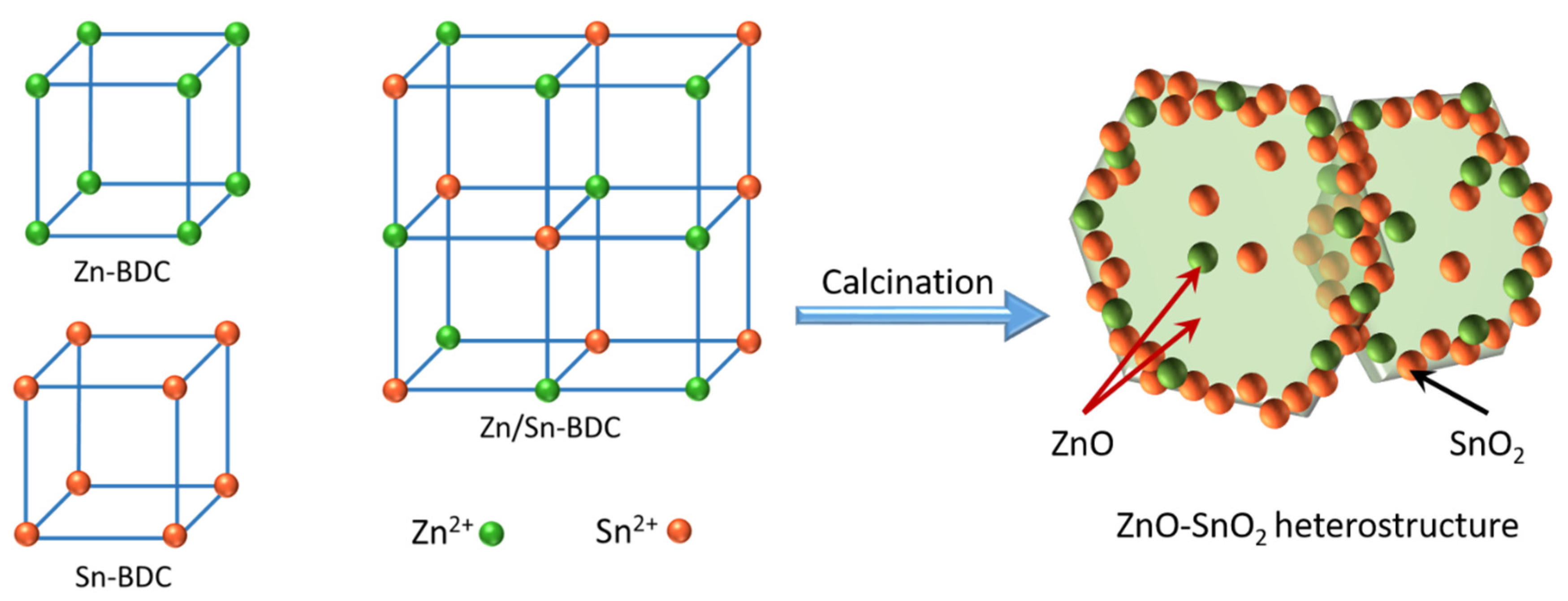
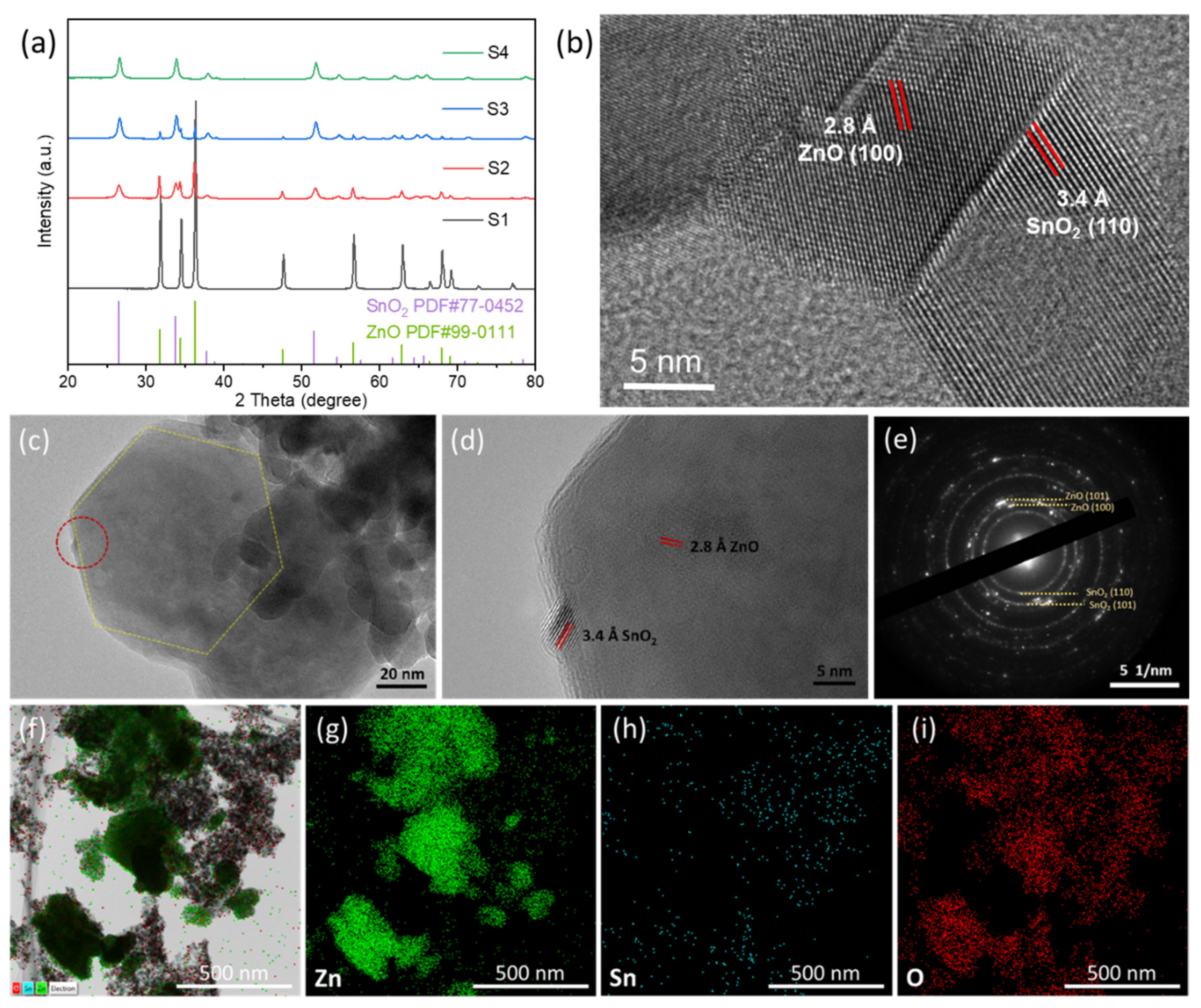
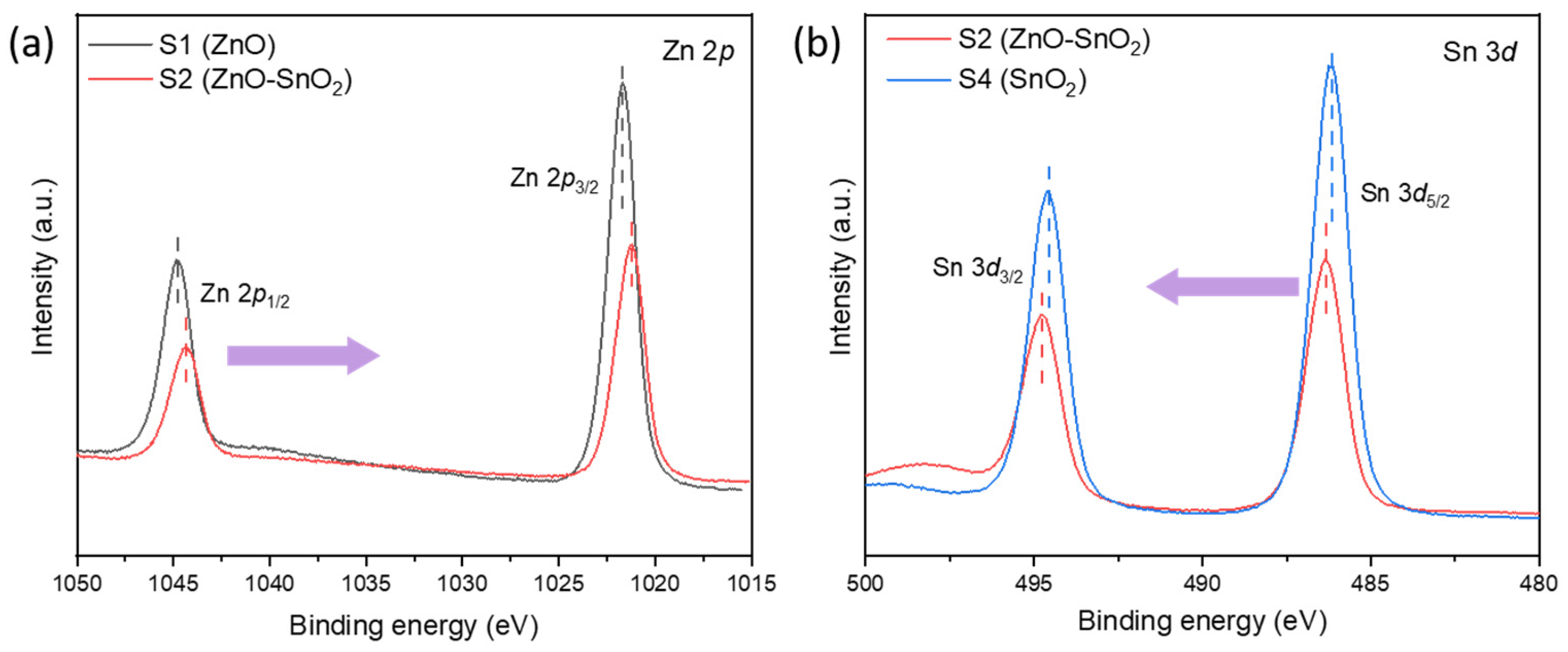
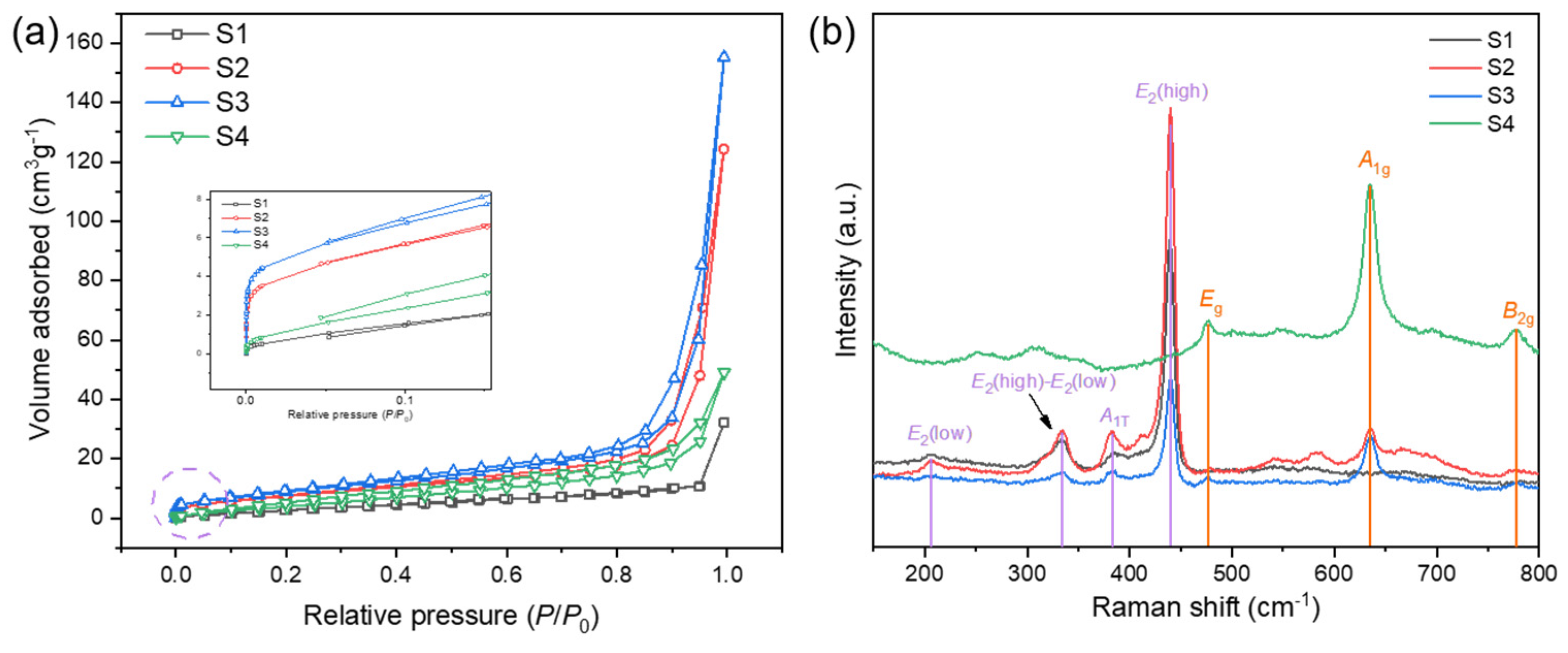
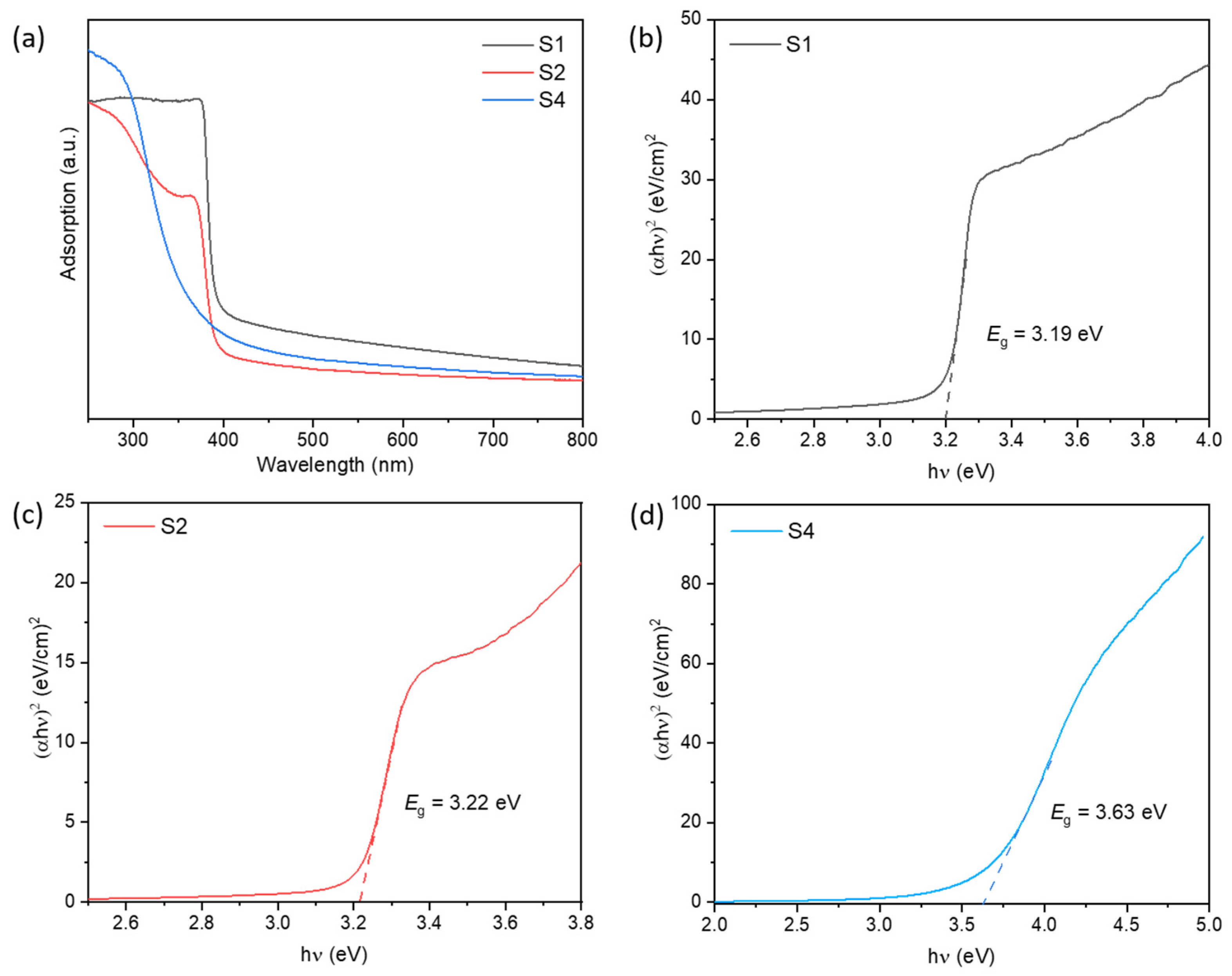
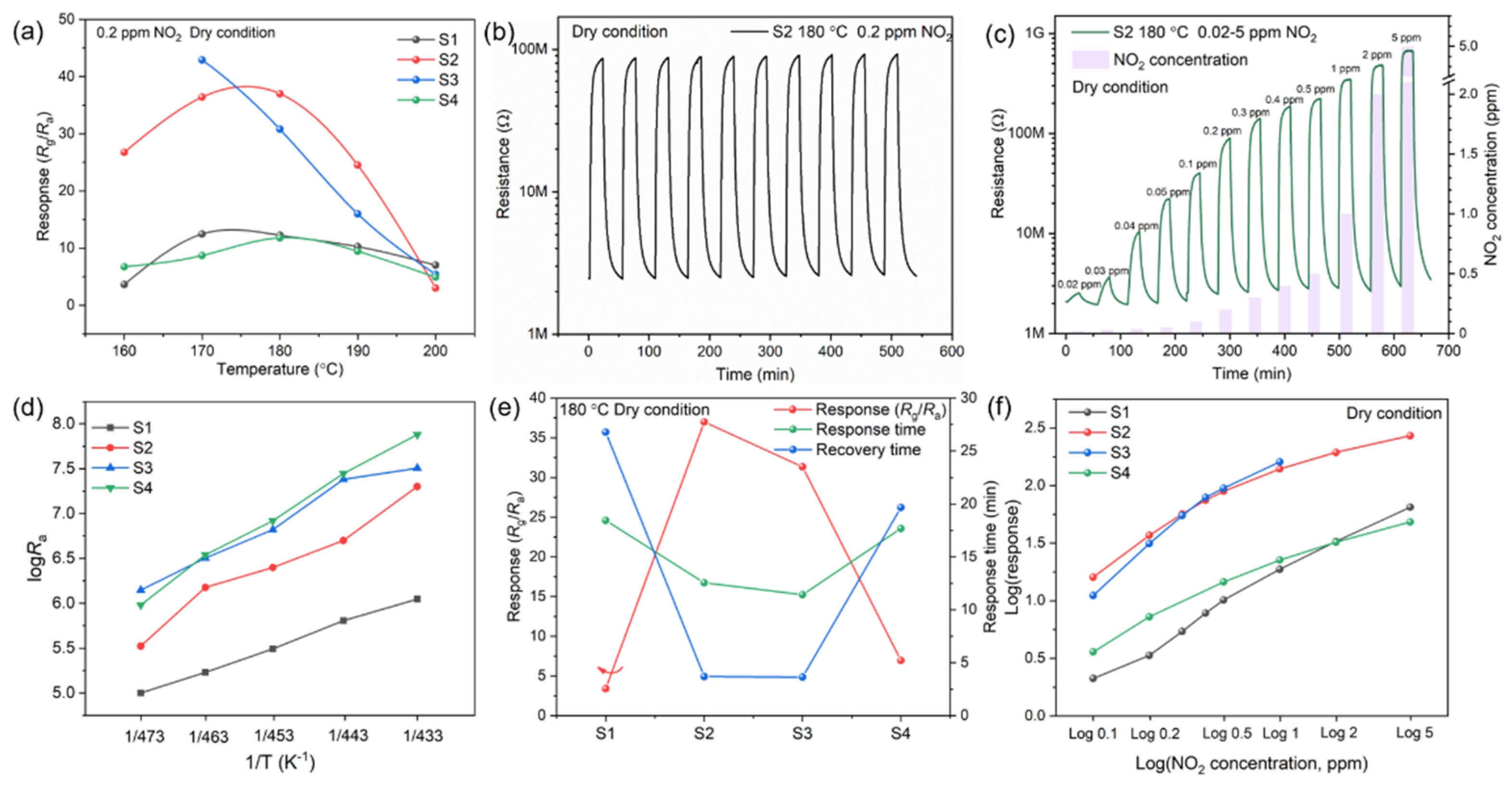


| Materials | NO2 (ppm) | Operating Temperature (°C) | Response (Rg/Ra or Ra/Rg) | Ref. |
|---|---|---|---|---|
| ZnO nanoneedles | 5 | 195 | 6 | [36] |
| SnO2-Sn3O4 heterostructure | 0.2 | 150 | 11 | [37] |
| ZnO@rGO | 10 | RT | 6.77 | [38] |
| MXene sphere/ZnO | 100 | RT | 1.72 | [39] |
| Sputtered SnO2/ZnO | 5 | 100 | 26.4 | [40] |
| ZnO-SnO2 hetero-nanowires | 0.25 | 150 | 17 | [41] |
| ZnO–SnO2 composite | 1 | 350 | 21.5 | [42] |
| ZnO nanorod/SnO2 film | 50 | 300 | 1.37 | [43] |
| SnO2@ZnO | 1 | 150 | 25 | [44] |
| ZnO-SnO2 heterojunction | 0.2 | 180 | 37 | this work |
Publisher’s Note: MDPI stays neutral with regard to jurisdictional claims in published maps and institutional affiliations. |
© 2022 by the authors. Licensee MDPI, Basel, Switzerland. This article is an open access article distributed under the terms and conditions of the Creative Commons Attribution (CC BY) license (https://creativecommons.org/licenses/by/4.0/).
Share and Cite
Ren, X.; Xu, Z.; Zhang, Z.; Tang, Z. Enhanced NO2 Sensing Performance of ZnO-SnO2 Heterojunction Derived from Metal-Organic Frameworks. Nanomaterials 2022, 12, 3726. https://doi.org/10.3390/nano12213726
Ren X, Xu Z, Zhang Z, Tang Z. Enhanced NO2 Sensing Performance of ZnO-SnO2 Heterojunction Derived from Metal-Organic Frameworks. Nanomaterials. 2022; 12(21):3726. https://doi.org/10.3390/nano12213726
Chicago/Turabian StyleRen, Xiaowei, Ze Xu, Zhongtai Zhang, and Zilong Tang. 2022. "Enhanced NO2 Sensing Performance of ZnO-SnO2 Heterojunction Derived from Metal-Organic Frameworks" Nanomaterials 12, no. 21: 3726. https://doi.org/10.3390/nano12213726
APA StyleRen, X., Xu, Z., Zhang, Z., & Tang, Z. (2022). Enhanced NO2 Sensing Performance of ZnO-SnO2 Heterojunction Derived from Metal-Organic Frameworks. Nanomaterials, 12(21), 3726. https://doi.org/10.3390/nano12213726






